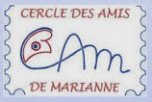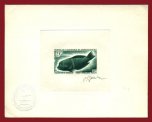
Sommaire
- Introduction
- Printing principle on a TD6 press
- Printing method of TD6 sheets
- Phosphor bands
- The printings of the stamp 0,50F Marianne de Béquet on TD6 presses
- 1st printing, on the press TD6-1
- 2nd printing, on the press TD6-7
- 3rd printing, on the press TD6-2
- 4th printing, on the press TD6-1
- 5th printing, on the press TD6-3
- 6th printing, on the press TD6-4
- 9th printing, on the press TD6-1
- 10th printing, on the press TD6-4
- 11th printing, on the press TD6-1
- 12th printing, on the press TD6-3
- 13th printing, on the press TD6-4
- 14th printing, on the press TD6-5
- 15th printing, on the press TD6-3
- 16th printing, on the press TD6-7
- 17th printing, on the press TD6-4
- 18th printing, on the press TD6-4
- 19th printing, on the press TD6-4
- 20th printing, on the press TD6-1
- 21st printing, on the press TD6-4
- 22nd printing, on the press TD6-7
- 23rd printing, on the press TD6-6
- 24th printing, on the press TD6-4
- 25th printing, on the press TD6-1
- 26t printing, on the press TD6-4
- 27th printing, on the press TD6-6
- 28th printing, on the press TD6-7
- 29th printing, on the press TD6-2
- 30th printing, on the press TD6-5
- 31st printing, on the press TD6-4
- 32nd printing, on the press TD6-4
- 33rd printing, on the press TD6-6
- 34th printing, on the press TD6-2
- 35th printing, on the press TD6-1
- 36th printing, on the press TD6-2
- 37th printing, on the press TD6-7
- 38th printing, on the press TD6-1
- 39th printing, on the press TD6-6
- 40th printing, on the press TD6-7
- Some statistics as a conclusion
Introduction
In this article, we will first explain the printing principle on a TD6 press and then the way sheets of stamps are printed on such a press. We will also present the notion of phosphor band and the four types of such bands known for the stamp 0,50F Marianne de Béquet. We will finally describe and illustrate all the known printings for the stamp 0,50F Marianne de Béquet on TD6 presses.
Printing principle on a TD6 press
A six-colour intaglio printing machine (TD6 press) is made of two printing blocks of three colours, various items for additional printings, a perforator and an output device, either in the form of sheets or in the form of booklets (cf. the article Preparation of booklets).
The first printing block is an indirect recess printing one. This first printing will have no relief (this block generally prints swaths of colour such as backgrounds). The form cylinder is engraved and the image is upright. After inking with cut touch rollers and wiping, the ink is deposited by pressure, with images back to front, on a transfer cylinder in soft plastic which, in turn, deposits ink by pressure in the face of the paper, as in offset. Printing is then dried in an infrared tunnel.
The second printing is direct line-engraving. The form cylinder is engraved, with the image upside down, to have a printing of the image upright. Inking is obtained by three hand cut touch rollers. A wiping roller removes excess ink to leave it only in the grooves of the engraving. After a second wetting of the paper, the form cylinder directly deposits ink by pressure of an impression cylinder, itself pressed by a counter-pressure cylinder. This printing is again dried and rapidly cooled on contact with hollow cylinders in which some cold water passes to create a thermal shock.
Stamps are then perforated by a comb. On a TD6 press, a comb is made of two horizontal rows of pins with the sheet of stamps width and of 11 side rows.
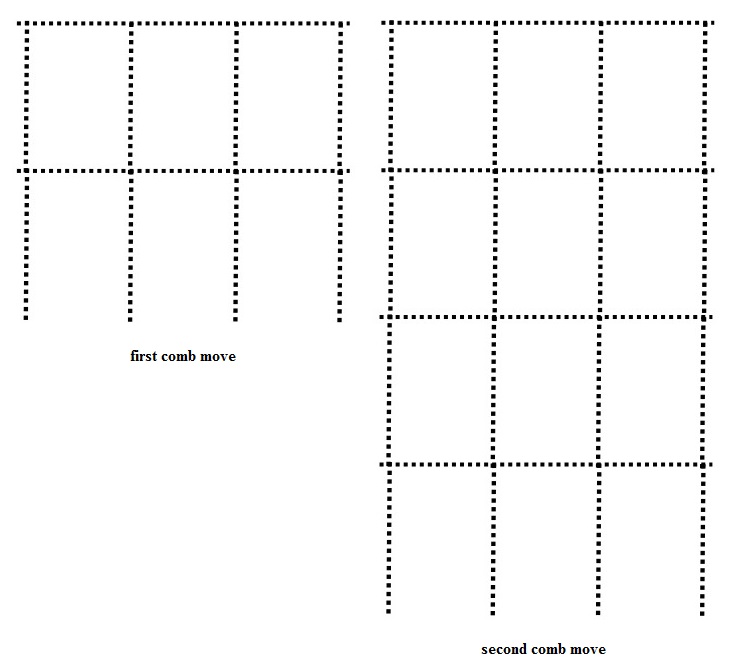
- comb operation on a TD6 press
Phosphor bands (for printings with such bands) are then printed with some UV ink and immediately dried by an UV dryer. Several printing systems of these bands have been used, we shall return there farther.
Printer’s markings are printed in letterpress by a cylinder with the control number, the number of the plate used to print the sheet and the date.
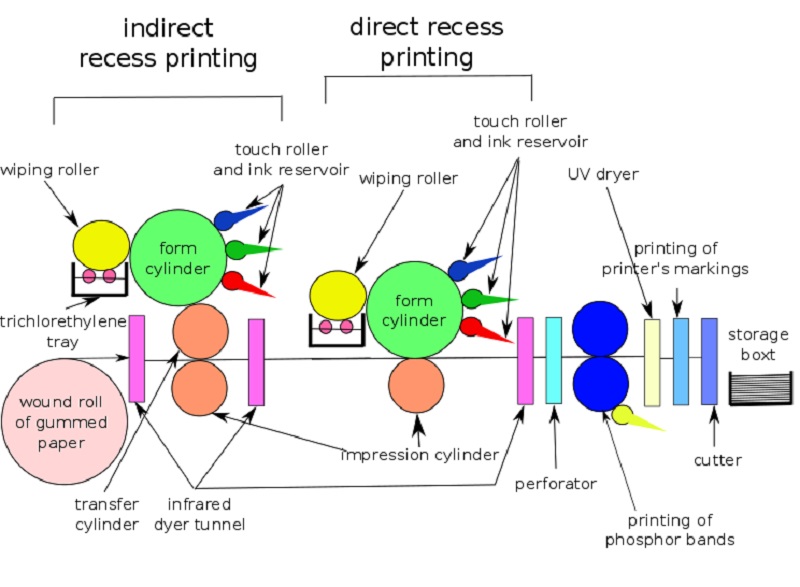
- basic diagram of a TD6 press
A rotating cutting cuts each sheet to let them overlap on a conveyor belt of reception where it only remains to stack them by packages of one thousand.
It is always possible to only use a single ink reservoir to produce a monochrome printing (which is the case for the stamp 0,50F Marianne de Béquet). In this case, the touch roller will not be cut.
The drying, to avoid mixtures of colours and spots, is a major concern throughout the run on a TD6 press. A TD6 press has an infrared dryer tunnel and paper passes four times in this tunnel:
- Before printing: the paper undergoes a preheating to lose the maximum moisture. This operation, which causes an important shrinking of paper, allows to limit its dimensional variations during the drying of the indirect recess printing;
- After indirect recess printing: the paper goes back in the dryer tunnel to dry ink and to avoid any maculation and mixture of colours during the direct line-engraving printing;
- After direct line-engraving printing: this new passage allows to dry ink of the direct line-engraving printing and, thus, to perform the latest operations of sheet numbering, perforation and cutting;
- After printing phosphor bands.
Finally, stamps, once printed, are sent as parcels of 1000 sheets, probably to one post office by department. For that purpose, the printing office of Boulazac printed labels which appeared on the sent parcels:
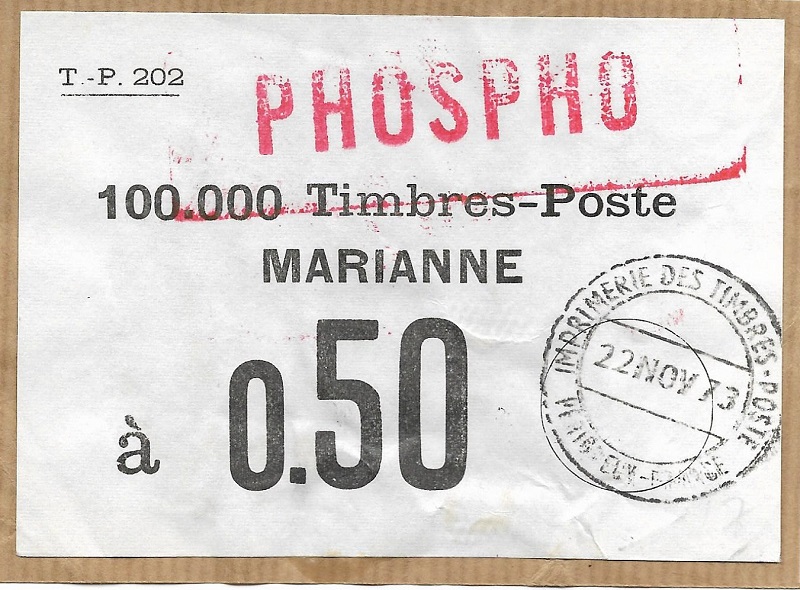
- label affixed to the package containing 1000 sheets of the stamp 0,50F Marianne de Béquet (with phosphor bands)
Printing method of TD6 sheets
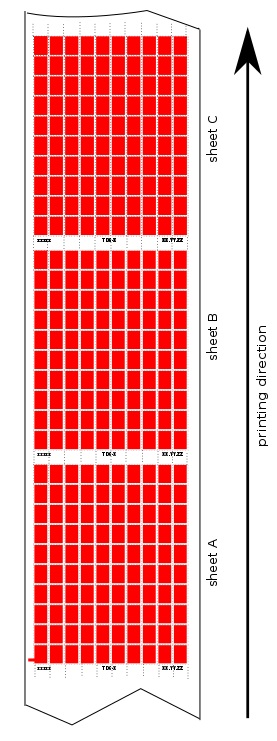
- printing scheme for sheets on a TD6 press
Every tour of the gravure printing cylinder prints bottom up three 100 stamps sheets, numbered from 00000 (= 100 000) to 00001, separated by a stamp height gutter, in which the guillotining of sheets will be performed.
The first sheet (sheet A on the figure on the left) has an electronic mark ( R.E. in French) on the left of stamp location 91 (it is worth noting that electronic marks are hand-engraved on the gravure printing cylinder to allow the electronic tracking of the second printing and of the perforation after optical character reading. Being hand-engraved, they have different shapes and are at different locations from each other with regard to stamps. This enables philatelists to describe and to study them). Sheet B has no mark and sheet C has two fine red lines under the stamp location 100 (for some printings, the two red lines are located in the left corner; for other editions, the two lines are not inked. This information will be given in the section about the description of printings).
On the following figure, we show the three dated plate blocks of 20 stamps printed by a single turn of a gravure printing cylinder (i.e. three sheets with consecutive control numbers). One can see the two red lines of the cylinder AG on the dated plate block numbered 10913 and the electronic mark of the same cylinder on the dated plate block numbered 10911.
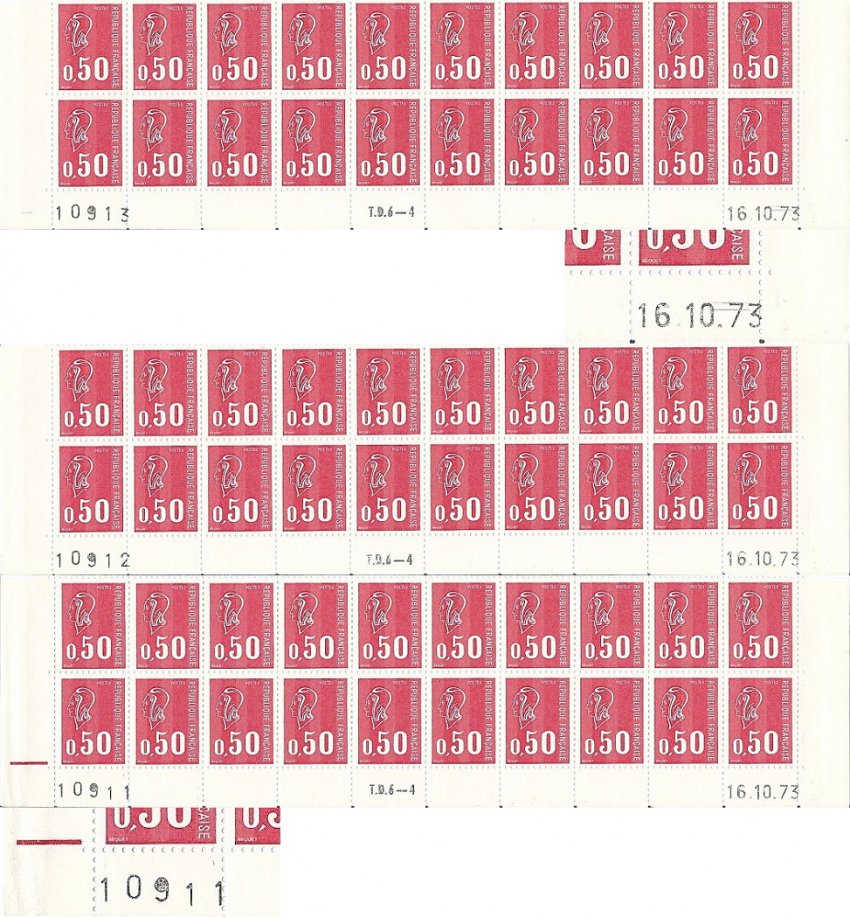
- three consecutive dated plate blocks of 20 stamps printed by the form cylinder AG
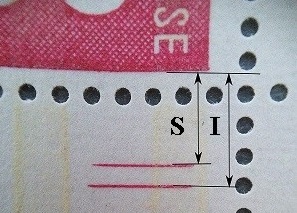
- characterization of a form cylinder by its two red lines
Philatelists (cf. SOCOCODAMI’s books for example) used to describe printings thanks to gravure printing cylinders and to characterize these cylinders by means of the two red lines appearing in the right corner of one in three sheets of stamps. We would like to recall here how these cylinders are characterized.
The two red lines are respectively called S (for Superior) and I (for Inferior). They are defined by the distances in millimetres between each of these lines and the bottom of the stamp situated just above (cf. the opposite image). For example, cylinder T is described on SOCOCODAMI’s book on Béquet by:
S = 4 3/4, I = 5 3/4, short lines to the right.
The control number is located under stamp location 91, the plate number TD6-x (x = 1 to 7) under stamp location 95, 96 or 97 and the printing date under stamp location 100.
A 100 stamps sheet measures approximately 285 mm high and 230 mm wide. Side margins are white and pinked, high and low margins white and vertically perforated.
Phosphor bands
Luminescence is the property that have certain substances to restore in the form of photons part of the energy absorbed during an excitement of a certain type (electric, chemical, mechanical, light energy,...). Fluorescence and phosphorescence are two different forms of luminescence: for fluorescence, the emission of photons is visible as long as the absorbed source of energy is active. For phosphorescence, the brilliance persists during a few seconds after the extinction of the source of energy, phenomenon which is called persistence.
Phosphor bands used for French stamps correspond to the above definition, ultraviolet light being used as source of energy of excitement, as shown by a note of the general management of the French Post authorities in 1973:
These bands are overprinted in letterpress or in flexography.
According to J.J. Rabineau’s work (see reference 20), four types of phosphor bands, denoted A, B, C and D, were defined for the first issues of stamps with phosphor bands (other types of phosphor bands will appear after the disappearance of the Marianne de Béquet and will not be described here). The characterization of each type of phosphor bands can be found below (the images come from the site LES BARRES PHOSPHORESCENTES ET LEURS VARIETES):
Type A bands
- Ink is viscous, thick and matt to the naked eye, hardly discernible in daylight ;
- Bands, which seem homogeneous under UV light, are printed in letterpress (by means of a metallic printing plate covered with bronze) and naturally dried.
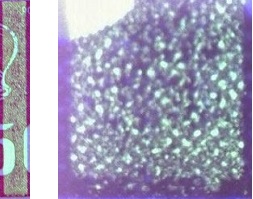
- type A phosphor band seen under UV light on the left, magnified 60 times on the right
Type B bands
- Ink is fluid (diluted with alcohol), matt, hardly discernible in daylight;
- Bands have a peripheral tide line and are more or less hollow and very heterogeneous under UV light; they are printed in letterpress (by means of a metallic printing plate covered with plastic) and infrared dried.
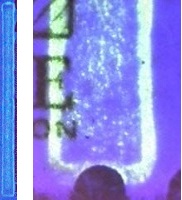
- type B phosphor band seen under UV light on the left, magnified 60 times on the right
Type C bands
- Ink is viscous, thick and pasty in the naked eye, brilliant in glancing light;
- Bands are rather heterogeneous under UV light, with a more or less broad peripheral tide line; they are printed in letterpress by means of a rubber or plastic printing plate and UV dried.
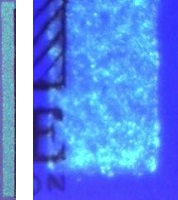
- type C phosphor band seen under UV light on the left, magnified 60 times on the right
Type D bands
- Ink is viscous, thick and slightly brilliant in the naked eye and in low-angled light, highly visible in daylight;
- Bands have a soft peripheral tide line under UV light with a more or less pronounced dotted aspect; they are printed in letterpress by means of a metallic printing plate and infrared dried.
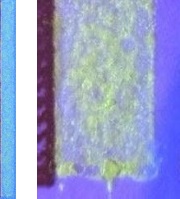
- type D phosphor band seen under UV light on the left, magnified 60 times on the right
The stamp 0,50F Marianne de Béquet is 20 mm wide and 26 mm tall: the figurine is 17 mm wide and 22,5 mm tall, which leaves a margin of 1,5 mm on each side. Phosphor bands are 3 mm wide and 22 mm tall.
The printings of the stamp 0,50F Marianne de Béquet on TD6 presses
During the manufacturing period of the stamp 0,50F Marianne de Béquet, TD6 presses printed
- Stamps without phosphor band, with normal gum (20 printings on the presses TD6-1, TD6-2, TD6-3, TD6-4, TD6-5 and TD6-7) or with tropical gum (2 printings on the presses TD6-2 and TD6-4);
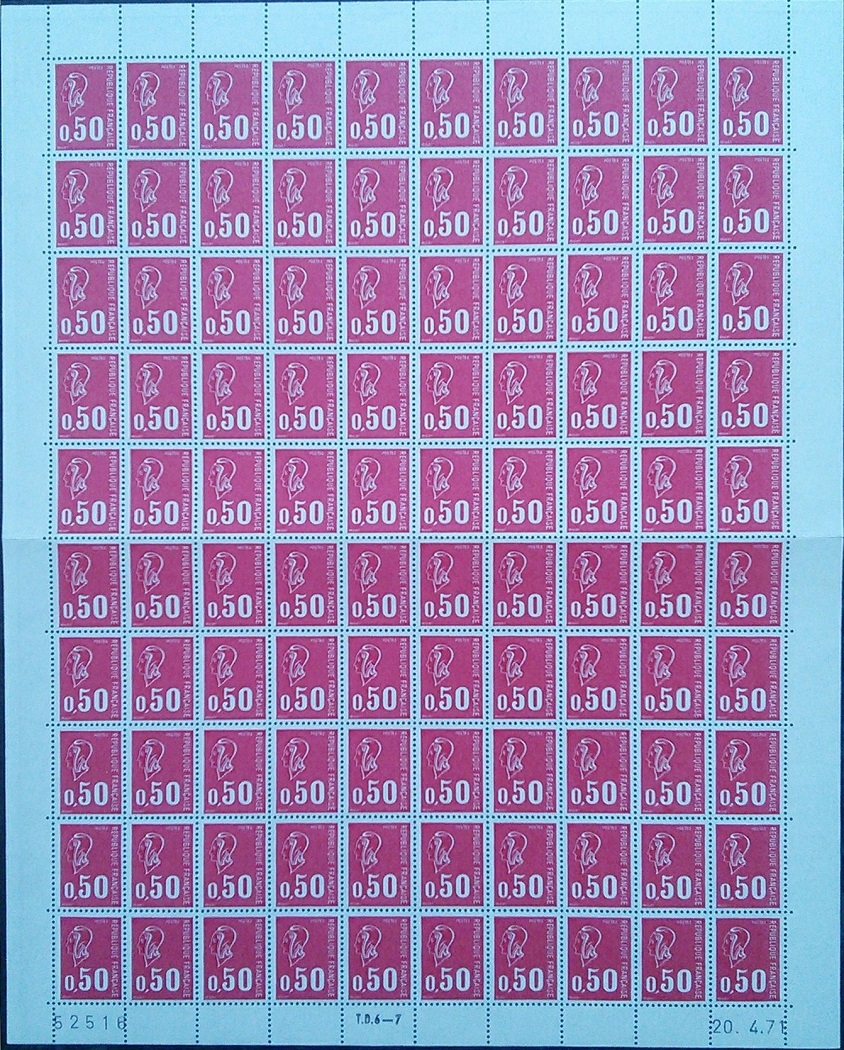
- sheet of 100 stamps without phosphor band
- Stamps without phosphor band overprinted 25F CFA on a flatbed printing press with normal gum (2 printings on the press TD6-1) or with tropical gum (2 printings on the presses TD6-1 and TD6-4);
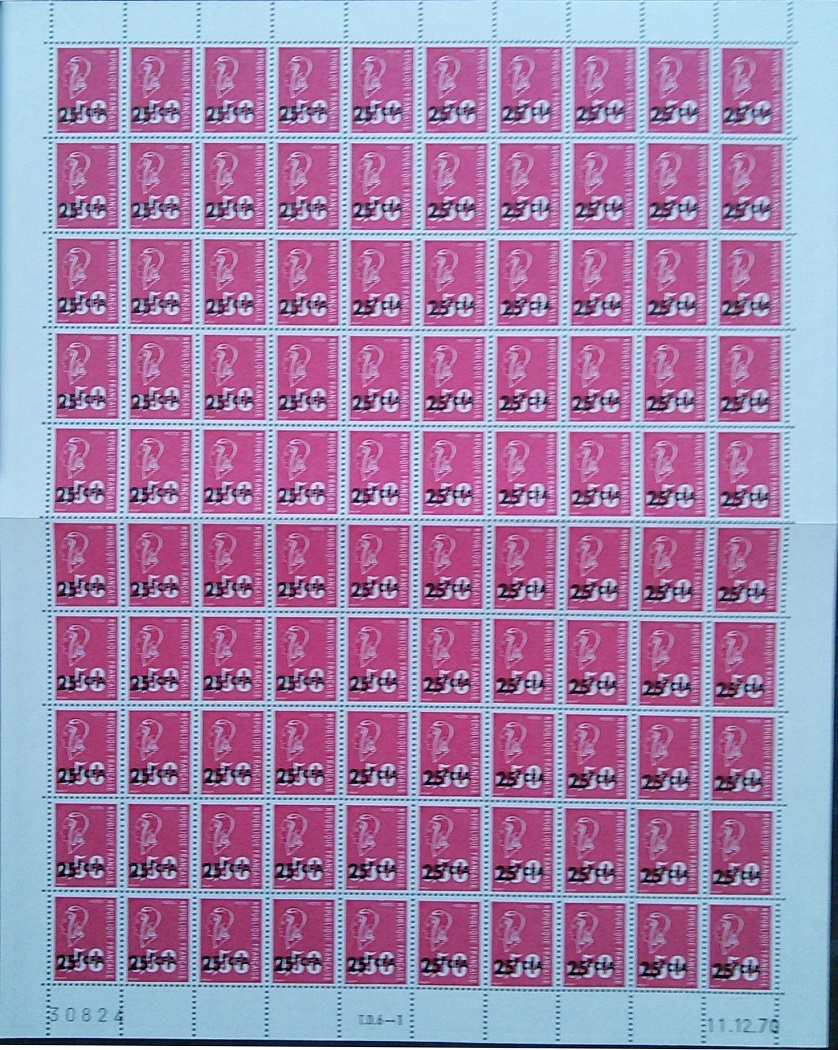
- sheet of 100 stamps 0,50F Marianne de Béquet overprinted 25F CFA
- Stamps with 3 phosphor bands, with normal gum: 18 printings
-
- on the press TD6-1, with type A or type D phosphor bands;
- on the press TD6-2, with type D phosphor bands;
- on the press TD6-4, with type A or type D phosphor bands;
- on the press TD6-5, with type D phosphor bands;
- on the press TD6-6, with type B phosphor bands;
- on the press TD6-7, with type B phosphor bands)
- Stamps with 3 phosphor bands, with tropical gum (1 printing on the press TD6-4, with type D phosphor bands and 1 printing on the press TD6-7, with type B phosphor bands).
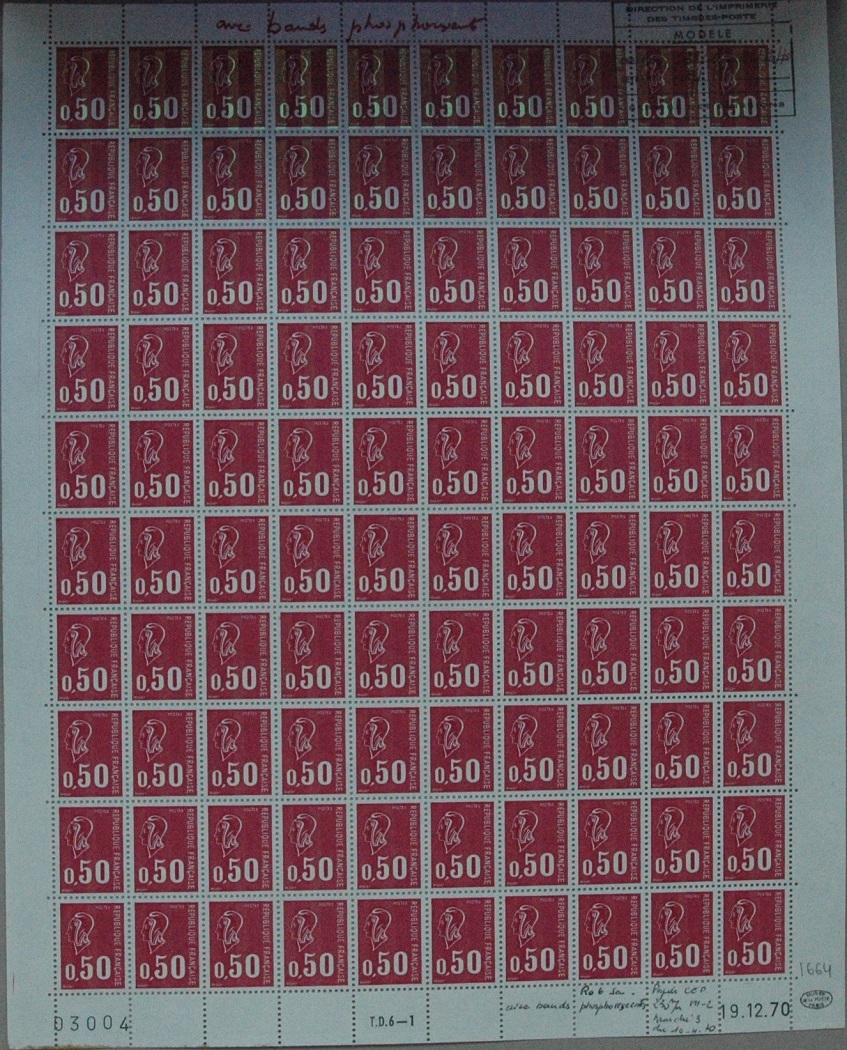
- imprimatur sheet of the stamp 0,50F Marianne de Béquet with 3 phosphor bands (Source : Copyright Coll. L’Adresse Musée de La Poste, Paris / La Poste)
Overall, there were 38 printings on TD6 presses, obtained using 36 gravure printing cylinders called A to AO. We will now illustrate all these printings, by showing, when possible, the electronic mark and the characteristic red lines of each gravure printing cylinder. But first, we will sum up all the printings in table format:
Note: In the following, we will write cylinder instead of gravure printing cylinder.
1st printing, on the press TD6-1
- cylinder A, from 27.11.70 to 10.12.70, stamps without phosphor band
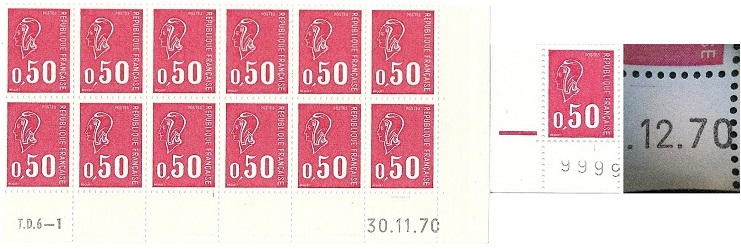
- dated plate block of 12 stamps from the 1st printing with the cylinder A, RE and 2 lines from the cylinder A
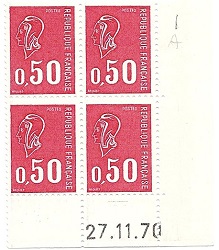
- corner dated block of 4 stamps from the 1st printing day of the stamp 0,50F Marianne de Béquet
- cylinder A, overprinted 25F C.F.A. on 11.12.70, metropolitan gum, stamps without phosphor band
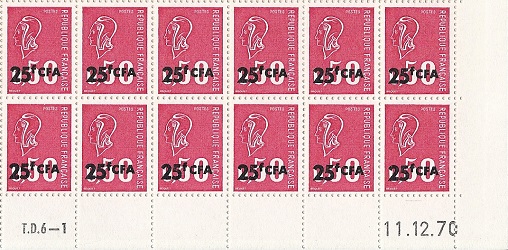
- dated plate block of 12 stamps from the 1st printing overprinted CFA
2nd printing, on the press TD6-7
- cylinder B, from 1.12.70 to 26.1.71, stamps without phosphor band

- dated plate block of 12 stamps from the 2nd printing with the cylinder B, RE and 2 lines from the cylinder B
The two lines are inked only from 22.1.71.
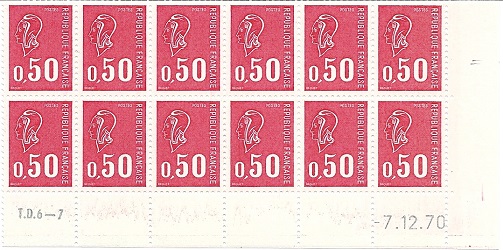
- dated plate block of 12 stamps from the 2nd printing with the cylinder B with the two lines dry printed
- cylinder D, from 1.2.71 to 10.2.71, stamps without phosphor band

- dated plate block of 12 stamps from the 2nd printing with the cylinder D, RE and 2 lines from the cylinder D
- cylinder I, from 11.2.71 to 16.2.71, stamps without phosphor band

- dated plate block of 12 stamps from the 2nd printing with the cylinder I, RE and 2 lines from the cylinder I
- cylinder J, from 17.2.71 to 27.2.71, stamps without phosphor band

- dated plate block of 12 stamps from the 2nd printing with the cylinder J, RE and 2 lines from the cylinder J
- cylinder C, from 5.3.71 to 18.6.71, stamps without phosphor band
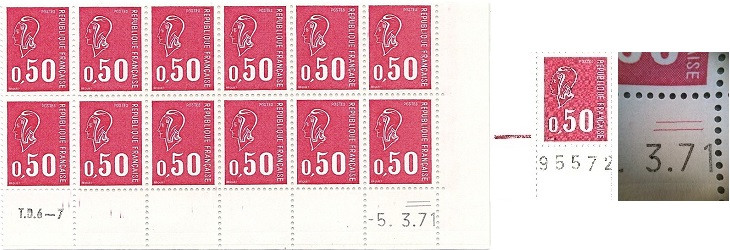
- dated plate block of 12 stamps from the 2nd printing with the cylinder C, RE and 2 lines from the cylinder C
- cylinder A, from 21.6.71 to 25.6.71, stamps without phosphor band
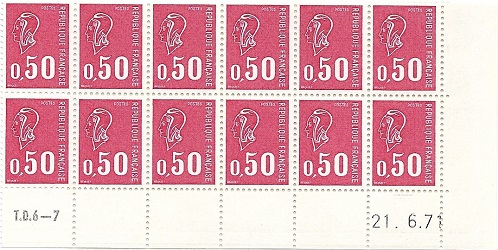
- dated plate block of 12 stamps from the 2nd printing with the cylinder A
3rd printing, on the press TD6-2
- cylinder C, from 5.12.70 to 1.2.71, stamps without phosphor band
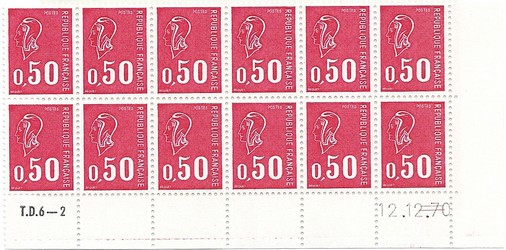
- dated plate block of 12 stamps from the 3rd printing with the cylinder C, RE and 2 lines from the cylinder C
Lines are non inked from 23.12.70
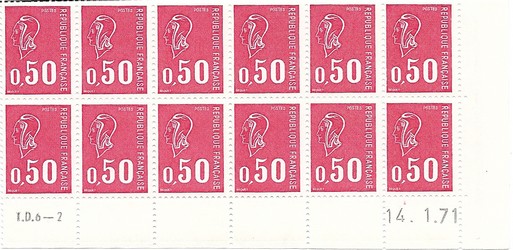
- dated plate block of 12 stamps from the 3rd printing with the cylinder C with the two lines dry printed
- cylinder H, from 10.2.71 to 17.4.71, stamps without phosphor band
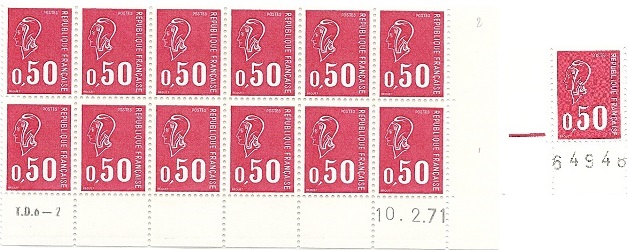
- dated plate block of 12 stamps from the 3rd printing with the cylinder H, RE from the cylinder H (there is no line in the block corner of the cylinder H)
- cylinder I, from 22.4.71 to 31.8.71, stamps without phosphor band
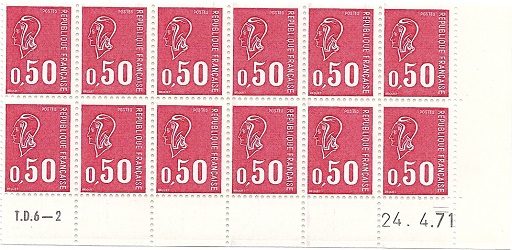
- dated plate block of 12 stamps from the 3rd printing with the cylinder I
- cylinder G, from 3.9.71 to 13.9.71, stamps without phosphor band

- dated plate block of 12 stamps from the 3rd printing with the cylinder G, RE and 2 lines from the cylinder G
- cylinder K, from 20.9.71 to 12.10.71, stamps without phosphor band

- dated plate block of 12 stamps from the 3rd printing with the cylinder K, RE and 2 lines from the cylinder K
- cylinder L, from 13.10.71 to 5.11.71,stamps without phosphor band

- dated plate block of 12 stamps from the 3rd printing with the cylinder L, RE and 2 lines from the cylinder L
4th printing, on the press TD6-1
- cylinder A, from 15.12.70 to 23.12.70, stamps with 3 type A phosphor bands
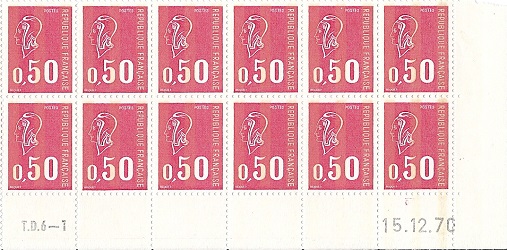
- dated plate block of 12 stamps from the 4th printing with the cylinder A, first printing day with type A phosphor bands
5th printing, on the press TD6-3
- cylinder D, from 22.12.70 to 16.1.71, stamps without phosphor band
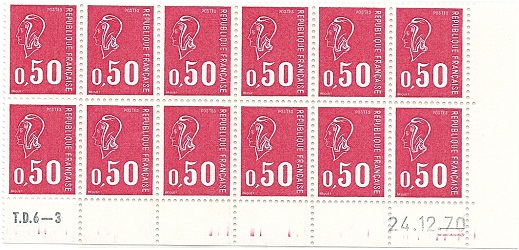
- dated plate block of 12 stamps from the 5th printing with the cylinder D
6th printing, on the press TD6-4
- cylindre G, du 9.1.71 au 18.1.71, stamps without phosphor band
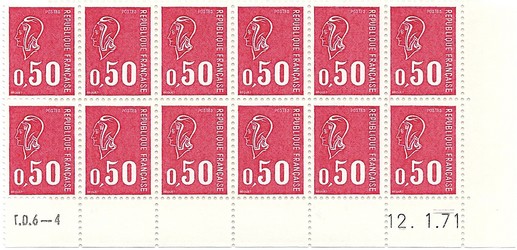
- dated plate block of 12 stamps from the 6th printing with the cylinder G
9th printing, on the press TD6-1
- 1st part
- cylinder A, from 28.12.70 to 30.12.70, overprinted 25F C.F.A., metropolitan gum, stamps without phosphor band
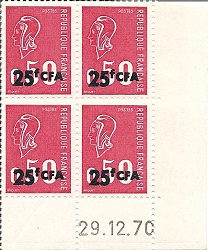
- dated plate block of 4 stamps from the 9th printing with the cylinder A overprinted 25F CFA
- cylinder A, from 28.12.70 to 30.12.70, overprinted 25F C.F.A., metropolitan gum, stamps without phosphor band
- 2nd part
- cylinder G, from 25.1.71 to 26.1.71, overprinted 25F C.F.A., metropolitan gum, on 25.1 et a part of 26.1, stamps without phosphor band
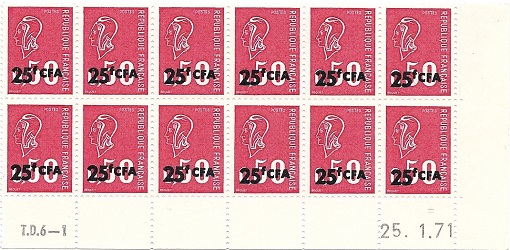
- dated plate block of 12 stamps from the 9th printing with the cylinder G overprinted 25F CFA

- dated plate block of 4 stamps from the 9th printing on 26.1.71 with the cylinder G overprinted 25F CFA on the left and dated plate block of 12 stamps from the 9th printing on 26.1.71 with the cylinder G non overprinted 25F CFA
- cylinder G, from 25.1.71 to 26.1.71, overprinted 25F C.F.A., metropolitan gum, on 25.1 et a part of 26.1, stamps without phosphor band
10th printing, on the press TD6-4
- cylinder A, from 3.5.71 to 18.6.71, stamps without phosphor band
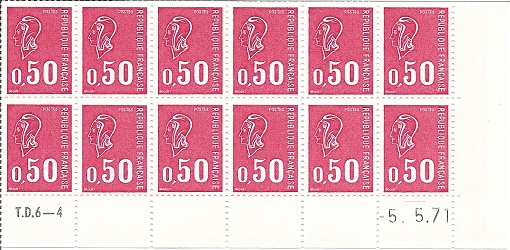
- dated plate block of 12 stamps from the 10th printing with the cylinder A
- cylinder C, from 21.6.71 to 2.9.71, stamps without phosphor band
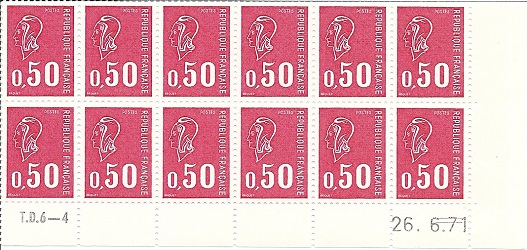
- dated plate block of 12 stamps from the 10th printing with the cylinder C
11th printing, on the press TD6-1
- cylinder H, from 26.8.71 to 9.9.71, stamps with 3 type A phosphor bands
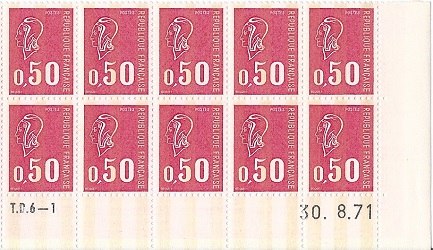
- dated plate block of 12 stamps from the11th printing with the cylinder H
- cylinder A, from 17.9.71 to 11.10.71, stamps with 3 type A phosphor bands
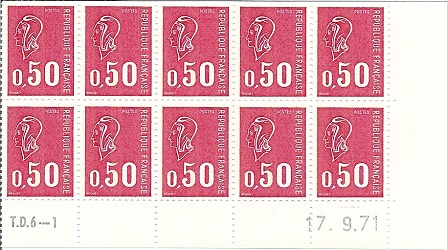
- dated plate block of 12 stamps from the 11th printing with the cylinder A
Lines are often dry printed from 28.9.71. - cylinder H, from 13.10.71 to 25.10.71, stamps with 3 type A phosphor bands
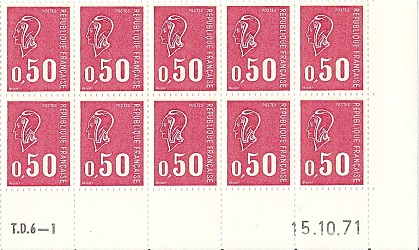
- dated plate block of 12 stamps from the 11th printing with the cylinder H
- cylinder G, from 27.10.71 to 20.11.71, stamps with 3 type A phosphor bands
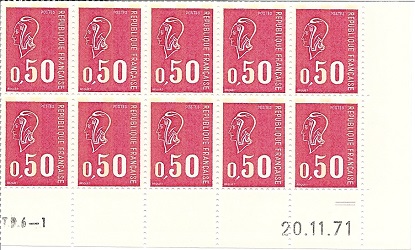
- dated plate block of 12 stamps from the 11th printing with the cylinder G
12th printing, on the press TD6-3
- cylinder C, on 9.9.71, stamps without phosphor band

- dated plate block of 4 stamps from the 13th printing with the cylinder C
- cylinder J, from 14.9.71 to 17.9.71, stamps without phosphor band
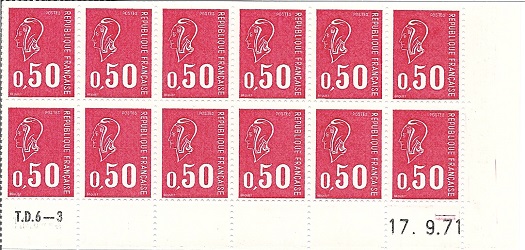
- dated plate block of 12 stamps from the 12th printing with the cylinder J
13th printing, on the press TD6-4
- 1st part
- cylinder K, from 16.10.71 to 2.12.71, stamps without phosphor band
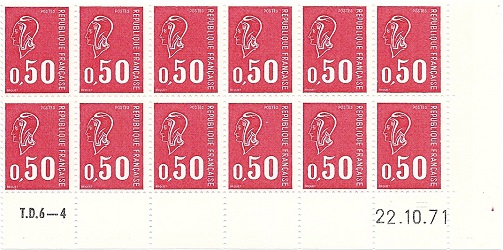
- dated plate block of 12 stamps from the 13th printing with the cylinder K
- cylinder N, from 4.12.71 to 22.12.71, stamps without phosphor band
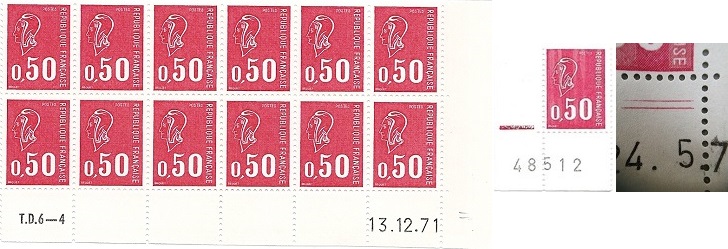
- dated plate block of 12 stamps from the 13th printing with the cylinder N, RE and 2 lines from the cylinder N
Lines are non inked.
- cylinder K, from 16.10.71 to 2.12.71, stamps without phosphor band
- 2nd part
- cylinder O, from 21.1.72 to 22.2.72, stamps without phosphor band

- dated plate block of 12 stamps from the 13th printing with the cylinder O, RE and 2 lines from the cylinder O
Lines are non inked until 14.2.71.
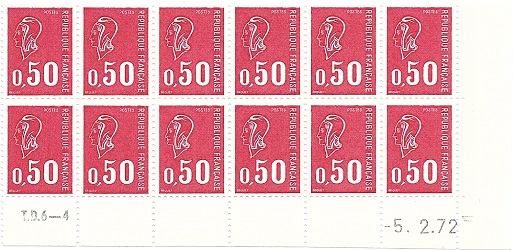
- dated plate block of 12 stamps from the 13th printing with the cylinder O with the two lines dry printed
- cylinder C, from 24.2.72 to 13.4.72, stamps without phosphor band
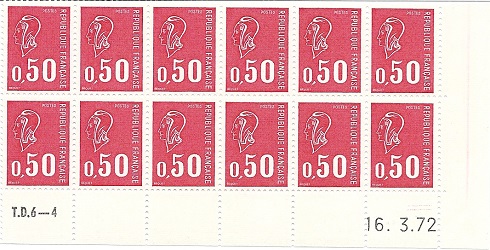
- dated plate block of 12 stamps from the 13th printing with the cylinder C
Lines are non inked from 7 to 13.3.72. - cylinder Q, from 18.4.72 to 21.4.72, stamps without phosphor band
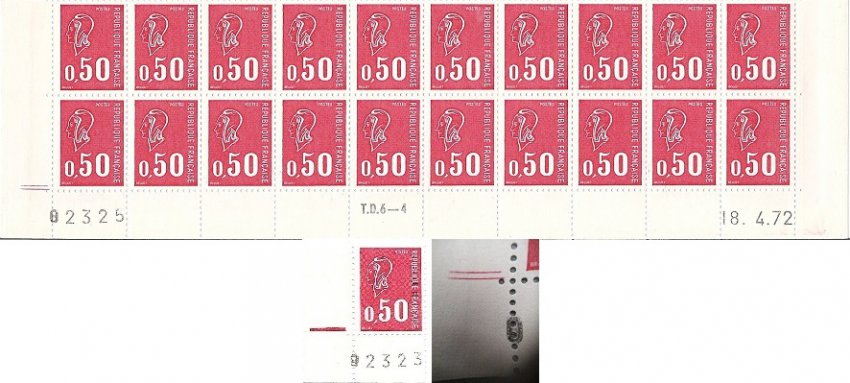
- dated plate block of 12 stamps from the 13th printing with the cylinder Q, RE and 2 lines from the cylinder Q (the two lines are located on the left block corner)
- cylinder R, from 2.5.72 to 10.6.72, stamps without phosphor band
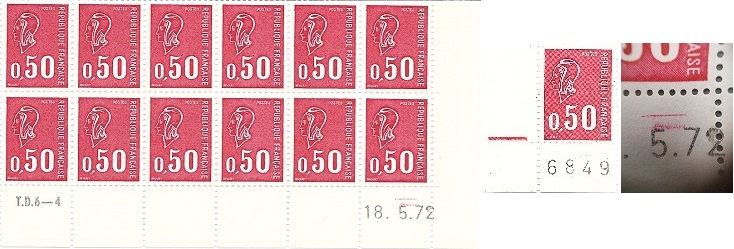
- dated plate block of 12 stamps from the 13th printing with the cylinder R, RE and 2 lines from the cylinder R
- cylinder O, from 21.1.72 to 22.2.72, stamps without phosphor band
14th printing, on the press TD6-5
- cylinder M, from 23.11.72 to 18.1.73, stamps without phosphor band
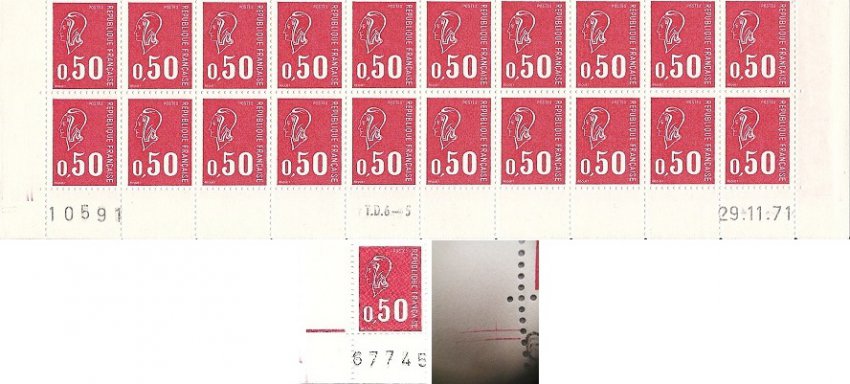
- dated plate block of 20 stamps from the 14th printing with the cylinder M, RE and 2 lines from the cylinder M (the two lines are located on the left block corner)
Lines are non inked, in the left corner.
15th printing, on the press TD6-3
- cylinder N, from 20.1.72 to 24.1.72, stamps without phosphor band
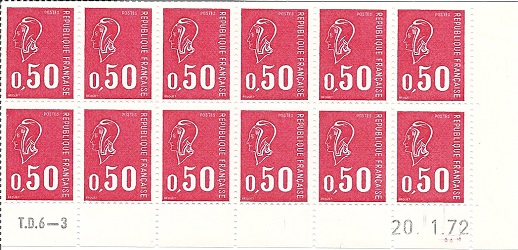
- dated plate block of 12 stamps from the 15th printing with the cylinder N
Two vertical lines can be found under the 100th stamp, at the number 5 level. - cylinder R, from 26.1.72 to 27.1.72, stamps without phosphor band
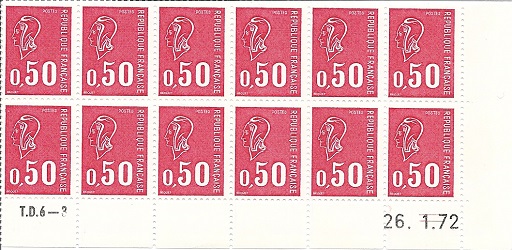
- dated plate block of 12 stamps from the 15th printing with the cylinder R
- cylinder P, from 31.1.72 to 10.3.72, stamps without phosphor band

- dated plate block of 12 stamps from the 15th printing with the cylinder P, RE and 2 lines from the cylinder P
16th printing, on the press TD6-7
- cylinder S, from 17.5.72 to 29.9.72, stamps without phosphor band
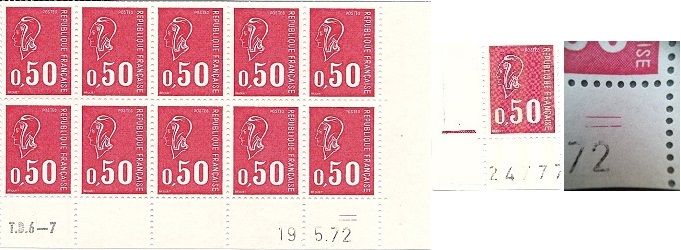
- dated plate block of 10 stamps from the 15th printing with the cylinder S, RE and 2 lines from the cylinder S
17th printing, on the press TD6-4
- cylinder R, from 12.6.72 to 16.6.72, stamps with 3 type A phosphor bands
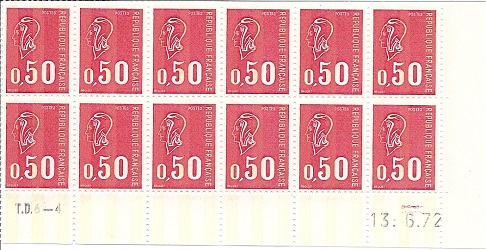
- dated plate block of 12 stamps from the 17th printing with the cylinder R
- cylinder T, from 19.6.72 to 21.7.72, stamps with 3 type A phosphor bands
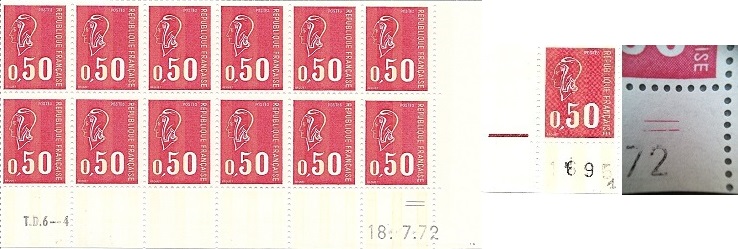
- dated plate block of 12 stamps from the 17th printing with the cylinder T, RE and 2 lines from the cylinder T
Lines are well inked only from 29.6.72.
18th printing, on the press TD6-4
- 1st part
- cylinder T, from 28.7.72 to 11.8.72, stamps without phosphor band
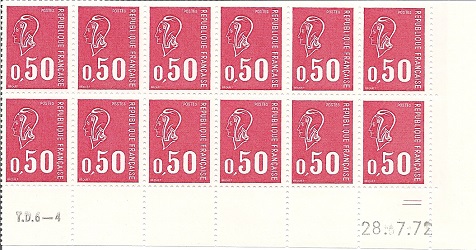
- dated plate block of 12 stamps from the 18th printing with the cylinder T
- cylinder T, from 28.7.72 to 11.8.72, stamps without phosphor band
- 2nd part
- cylinder Q, from 7.9.72 to 14.9.72, stamps without phosphor band

- dated plate block of 20 stamps from the 18th printing with the cylinder Q
- cylinder U, from 18.9.72 to 10.11.72, stamps without phosphor band
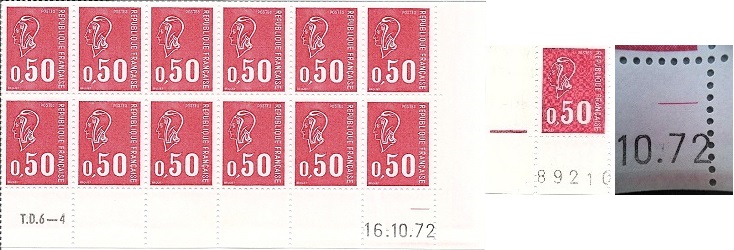
- dated plate block of 12 stamps from the 18th printing with the cylinder U, RE and 2 lines from the cylinder U
The upper line is inked from 3.10.72
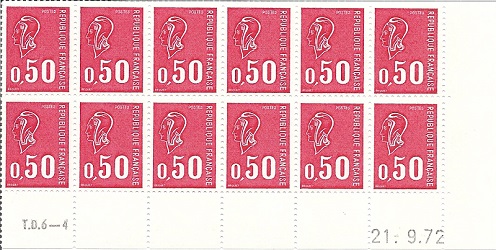
- dated plate block of 12 stamps from the 18th printing with the cylinder U
- cylinder S, from 13.11.72 to 4.12.72, stamps without phosphor band
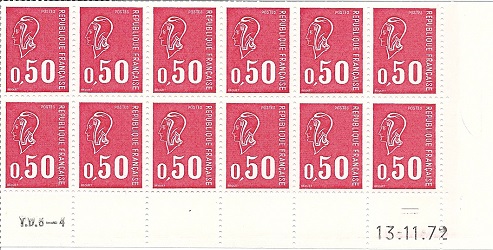
- dated plate block of 12 stamps from the 18th printing with the cylinder S
- cylinder Q, from 7.9.72 to 14.9.72, stamps without phosphor band
- 3rd part
- cylinder S, from 14.12.72 to 21.12.72, stamps without phosphor band
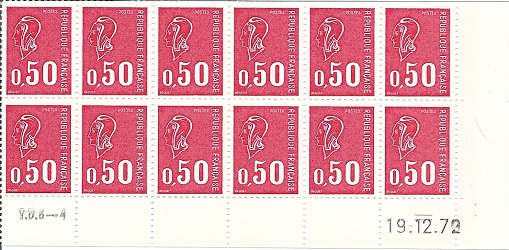
- dated plate block of 12 stamps from the 18th printing with the cylinder S
- cylinder S, from 14.12.72 to 21.12.72, stamps without phosphor band
19th printing, on the press TD6-4
- cylinder T, on 28.8.72, stamps with 3 type A phosphor bands

- dated plate block of 20 stamps from the 19th printing with the cylinder T
- cylinder Q, from 31.8.72 to 5.9.72, stamps with 3 type A phosphor bands

- dated plate block of 20 stamps from the 19th printing with the cylinder Q
20th printing, on the press TD6-1
- 1st part
- cylinder Q, from 11.10.72 to 27.11.72, stamps without phosphor band

- dated plate block of 20 stamps from the 20th printing with the cylinder Q
- cylinder Q, from 11.10.72 to 27.11.72, stamps without phosphor band
- 2nd part
- cylinder Q , from 20.12.72 to 3.1.73, stamps without phosphor band

- dated plate block of 20 stamps from the 20th printing with the cylinder Q
- cylinder Q , from 20.12.72 to 3.1.73, stamps without phosphor band
21st printing, on the press TD6-4
- 1st part
- cylinder S, on 5.12.72, stamps with 3 type A phosphor bands
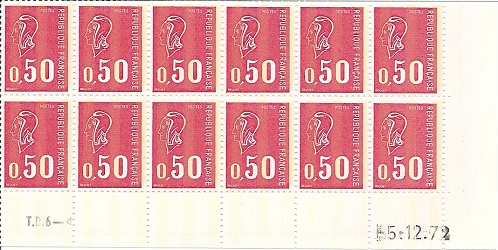
- dated plate block of 12 stamps from the 21st printing with the cylinder S
- cylinder S, on 5.12.72, stamps with 3 type A phosphor bands
- 2nd partie
- cylinder S, from 27.12.72 to 13.1.73, stamps with 3 type A phosphor bands
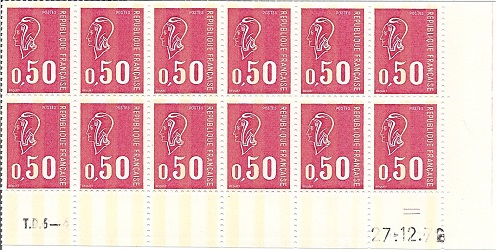
- dated plate block of 12 stamps from the 21st printing with the cylinder S
- cylinder V, from 16.1.73 to 6.2.73, stamps with 3 type D phosphor bands

- dated plate block of 12 stamps from the 21st printing with the cylinder V, RE and 2 lines from the cylinder V
Lines hardly inked or non inked.
- cylinder S, from 27.12.72 to 13.1.73, stamps with 3 type A phosphor bands
22nd printing, on the press TD6-7
- cylinder Q, from 6.1.73 to 9.1.73, stamps without phosphor band

- dated plate block of 20 stamps from the 21st printing with the cylinder Q
- cylinder W, from 16.1.73 to 23.1.73, stamps without phosphor band
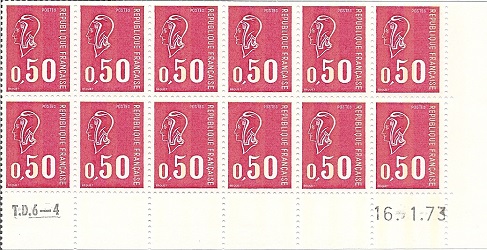
- dated plate block of 12 stamps from the 22nd printing with the cylinder W
- cylinder X, from 25.1.73 to 2.2.73, stamps without phosphor band
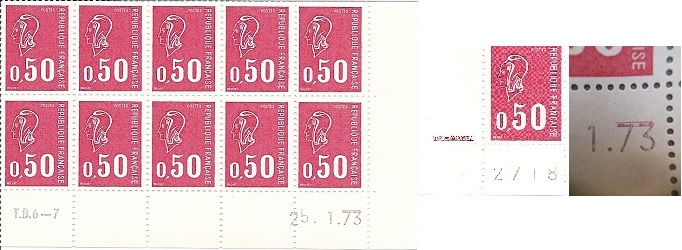
- dated plate block of 10 stamps from the 22nd printing with the cylinder X, RE and 2 lines from the cylinder X
- cylinder Y, on 6.2.73, stamps without phosphore band
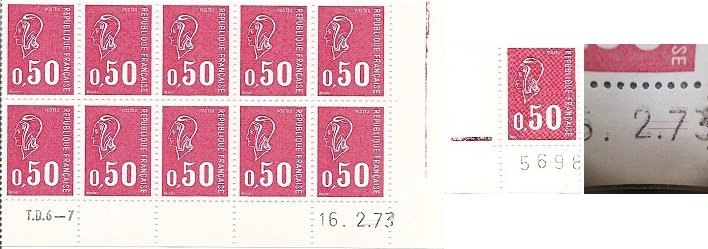
- dated plate block of 10 stamps from the 22nd printing with the cylinder Y, RE and 2 lines from the cylinder Y
- cylinder Z, from 8.2.73 to 14.2.73, stamps without phosphor band
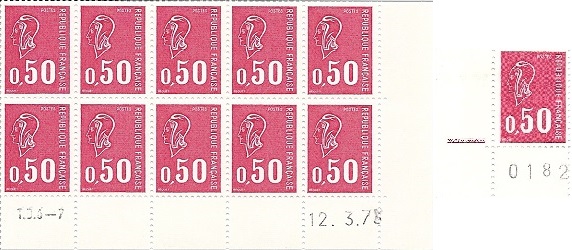
- dated plate block of 10 stamps from the 22nd printing with the cylinder Z, RE from the cylinder Z (the cylinder Z has no 2 lines in the tight corner of the sheet)
- cylinder AO, from 17.3.73 to 19.3.73, stamps without phosphor band
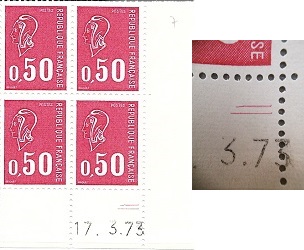
- dated plate block of 4 stamps from the 22nd printing with the cylinder AO and 2 lines from the cylinder AO
- cylinder AA, from 22.3.73 to 27.4.73, stamps without phosphor band
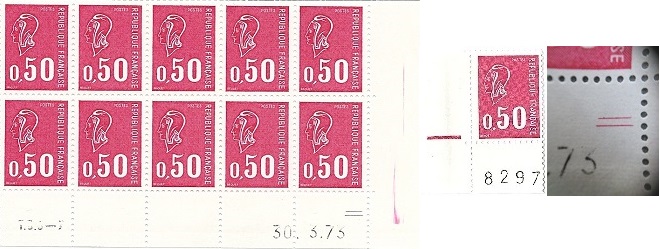
- dated plate block of 10 stamps from the 22nd printing with the cylinder AA, RE and 2 lines from the cylinder AA
- cylinder AD, from 3.5.73 to 12.5.73, stamps without phosphor band
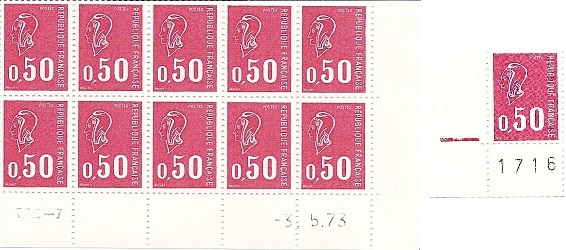
- dated plate block of 10 stamps from the 22nd printing with the cylinder AD, RE and 2 lines from the cylinder AD
- cylinder P, from 16.5.73 to 17.5.73, stamps without phosphor band
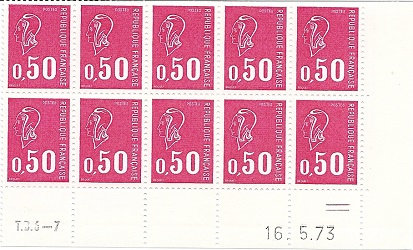
- dated plate block of 10 stamps from the 22nd printing with the cylinder P
23rd printing, on the press TD6-6
- cylinder P, from 12.3.73 to 13.3.73, stamps with 3 type D phosphor bands
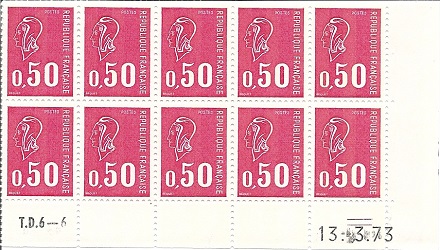
- dated plate block of 10 stamps from the 23rd printing with the cylinder P
24th printing, on the press TD6-4
- cylinder P, from 16.373 to 16.5.73, stamps with 3 type D phosphor bands
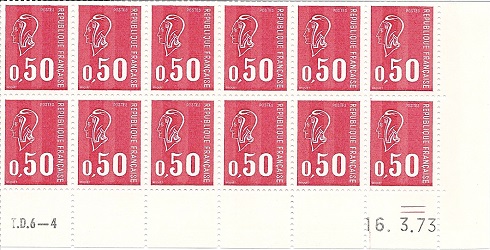
- dated plate block of 12 stamps from the 24th printing with the cylinder P
25th printing, on the press TD6-1
- cylinder AB, from 5.4.73 to 14.4.73, stamps without phosphor band

- dated plate block of 12 stamps from the 25th printing with the cylinder AB, RE and 2 lines from the cylinder AB
- cylinder AC, from 16.4.73 to 3.5.73, stamps without phosphor band

- dated plate block of 12 stamps from the 25th printing with the cylinder AC, RE and 2 lines from the cylinder AC
- cylinder AB, from 5.5.73 to 15.5.73, stamps without phosphor band
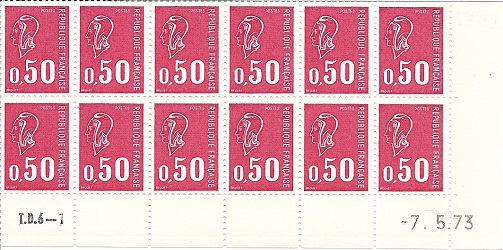
- dated plate block of 12 stamps from the 25th printing with the cylinder AB
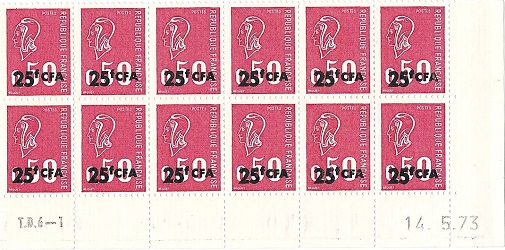
- dated plate block of 12 stamps from the 25th printing with the cylinder AB overprinted 25F CFA
26t printing, on the press TD6-4
- 1st part
- cylinder AB, from 18.6.73 to 3.7.73, stamps with 3 type D phosphor bands
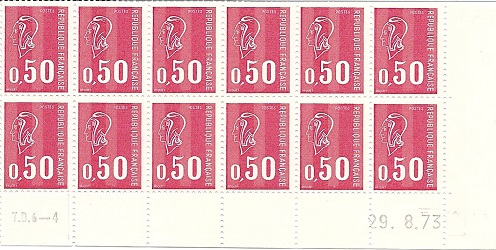
- dated plate block of 12 stamps from the 26th printing with the cylinder AB
- cylinder P, from 6.7.73 to 31.7.73, stamps with 3 type D phosphor bands
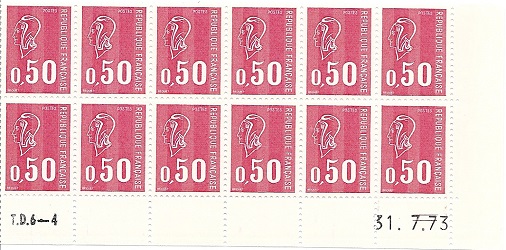
- dated plate block of 12 stamps from the 26th printing with the cylinder P
- cylinder AB, from 1.8.73 to 12.9.73, stamps with 3 type D phosphor bands
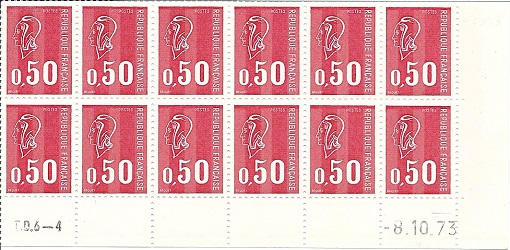
- dated plate block of 12 stamps from the 26th printing with the cylinder AB
- cylinder AE, from 13.9.73 to 3.10.73, stamps with 3 type D phosphor bands
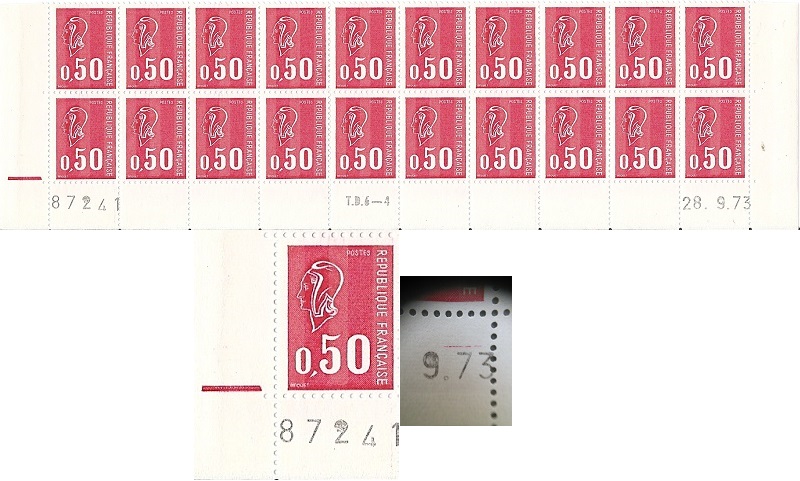
- dated plate block of 20 stamps from the 26th printing with the cylinder AE, RE and 2 lines from the cylinder AE
- cylinder AB, from 5.10.73 to 8.10.73, stamps with 3 type D phosphor bands
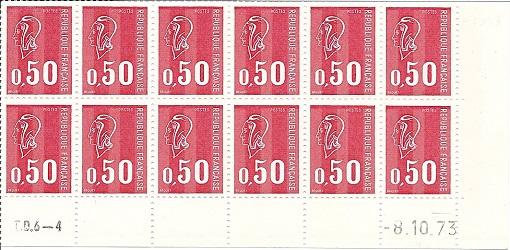
- dated plate block of 12 stamps from the 26th printing with the cylinder AB
- cylinder AG, from 10.10.73 to 17.11.73, stamps with 3 type D phosphor bands

- dated plate block of 12 stamps from the 26th printing with the cylinder AG, RE and 2 lines from the cylinder AG
- cylinder AH, from 20.11.73 to 30.11.73, stamps with 3 type D phosphor bands

- dated plate block of 12 stamps from the 26th printing with the cylinder AH, RE and 2 lines from the cylinder AH
- cylinder AG, from 5.12.73 to 14.12.73, stamps with 3 type D phosphor bands
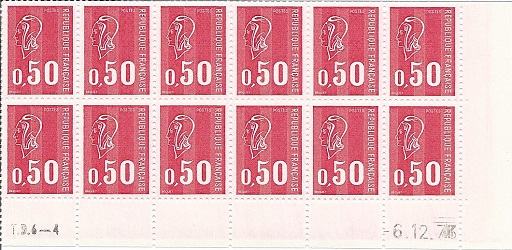
- dated plate block of 12 stamps from the 26th printing with the cylinder AG
- cylinder AK, from 17.12.73 to 1.2.74, stamps with 3 type D phosphor bands

- dated plate block of 12 stamps from the 26th printing with the cylinder AK, RE and 2 lines from the cylinder AK
- cylinder AL, from 1.2.74 to 5.3.74, stamps with 3 type D phosphor bands

- dated plate block of 12 stamps from the 26th printing with the cylinder AL, RE and 2 lines from the cylinder AL
Lines are dry printed but on 1 and 2.2.74.
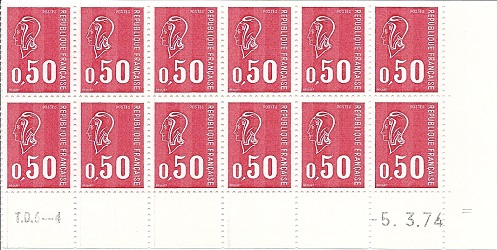
- dated plate block of 12 stamps from the 26th printing with the cylinder AL with the two lines dry printed
- cylinder AB, from 18.6.73 to 3.7.73, stamps with 3 type D phosphor bands
- 2nd part
- cylinder AL, from 19.3.74 to 29.3.74, stamps with 3 type D phosphor bands
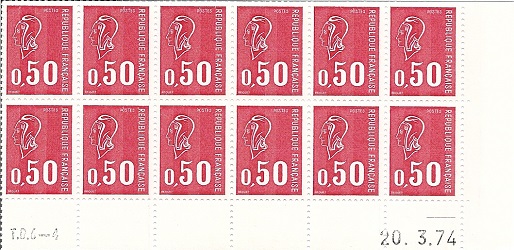
- dated plate block of 12 stamps from the 26th printing with the cylinder AL
Lines are non inked.
- cylinder AL, from 19.3.74 to 29.3.74, stamps with 3 type D phosphor bands
- 3rd part
- cylinder AL, from 10.4.74 to 22.4.74, stamps with 3 type D phosphor bands
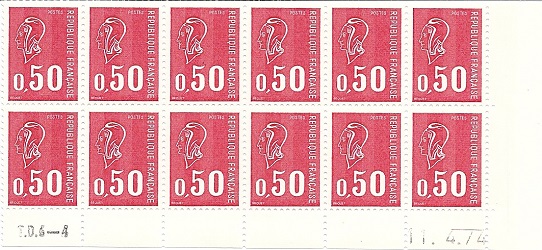
- dated plate block of 12 stamps from the 26th printing with the cylinder AL
Lines are non inked.
- cylinder AL, from 10.4.74 to 22.4.74, stamps with 3 type D phosphor bands
- 4th part
- cylinder AL, from 6.5.74 to 10.5.74, stamps with 3 type D phosphor bands
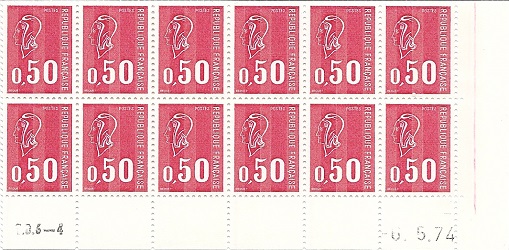
- dated plate block of 12 stamps from the 26th printing with the cylinder AL
Lines are non inked.
- cylinder AL, from 6.5.74 to 10.5.74, stamps with 3 type D phosphor bands
27th printing, on the press TD6-6
- cylinder AH, from 23.10.73 to 7.11.73, stamps with 3 type B phosphor bands
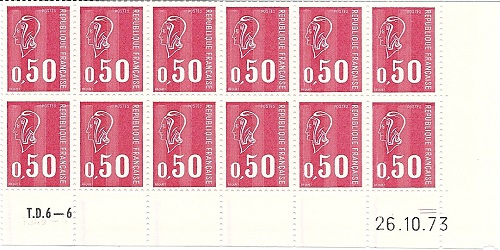
- dated plate block of 12 stamps from the 27th printing with the cylinder AH
The lower line is non inked on 23 and 24.10.73.
28th printing, on the press TD6-7
- cylinder AI, from 17.12.73 to 7.1.74, stamps without phosphor band
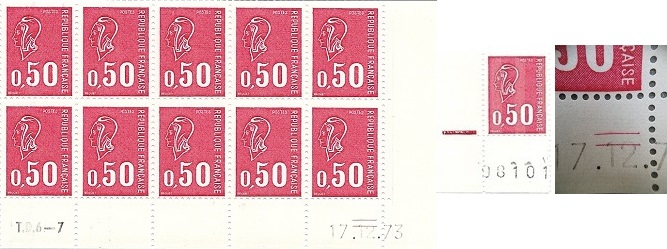
- dated plate block of 10 stamps from the 28th printing with the cylinder AI, RE and 2 lines from the cylinder AI
29th printing, on the press TD6-2
- 1st part
- cylinder AJ from 19.12.73 to 22.12.73, stamps without phosphor band
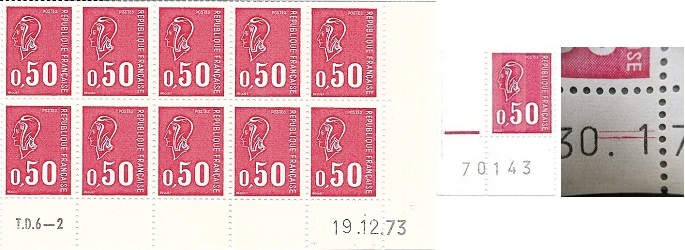
- dated plate block of 10 stamps from the 29th printing with the cylinder AJ, RE and 2 lines from the cylinder AJ
Lines are dry printed.
- cylinder AJ from 19.12.73 to 22.12.73, stamps without phosphor band
- 2nd part
- cylinder AJ, from 2.1.74 to 11.1.74, stamps without phosphor band
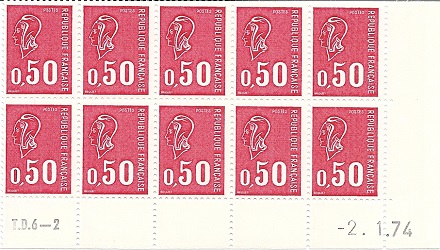
- dated plate block of 10 stamps from the 29th printing with the cylinder AJ
Lines are non inked. - cylinder AI, from 14.1.74 to 26.1.74, stamps without phosphor band
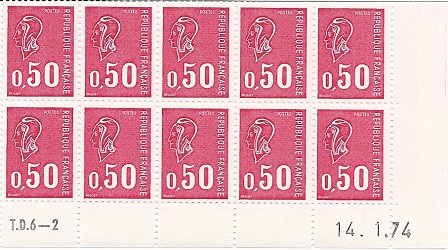
- dated plate block of 10 stamps from the 29th printing with the cylinder AI
Lines are non inked.
- cylinder AJ, from 2.1.74 to 11.1.74, stamps without phosphor band
- 3rd part
- cylinder AI, from 7.2.74 to 9.3.74, stamps without phosphor band
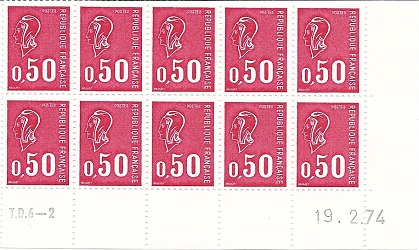
- dated plate block of 10 stamps from the 29th printing with the cylinder AI
Lines are non inked.
On 22 and 23.2.74, the printing was made on tropical gum ; this printing has been sold in la Réunion.
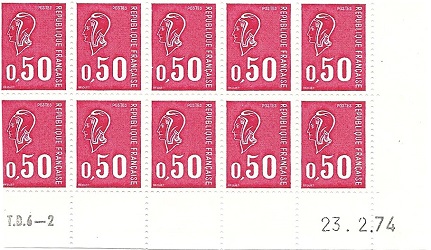
- dated plate block of 10 stamps from the 29th printing with the cylinder AI, tropical gum
- cylinder AI, from 7.2.74 to 9.3.74, stamps without phosphor band
30th printing, on the press TD6-5
- 1st part
- cylinder AJ, from 30.1.74 to 18.2.74, stamps with 3 type D phosphor bands
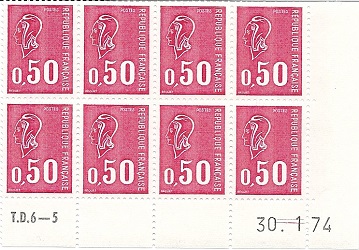
- dated plate block of 8 stamps from the 30th printing with the cylinder AJ
The plate number is under the 97th stamp.
- cylinder AJ, from 30.1.74 to 18.2.74, stamps with 3 type D phosphor bands
- 2nd part
- cylinder AJ, from 7.3.74 to 22.3.74, stamps with 3 type D phosphor bands
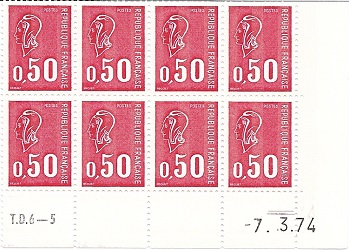
- dated plate block of 8 stamps from the 30th printing with the cylinder AJ
The plate number is under the 97th stamp. - cylinder AH , from 26.3.74 to 18.4.74, stamps with 3 type D phosphor bands
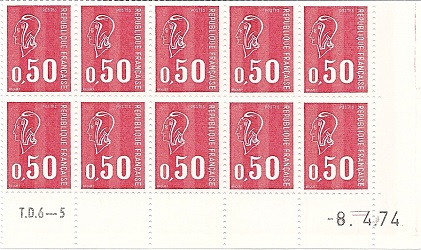
- dated plate block of 10 stamps from the 30th printing with the cylinder AH
The plate number is under the 96th stamp.
- cylinder AJ, from 7.3.74 to 22.3.74, stamps with 3 type D phosphor bands
- 3rd part
- cylinder AH, from 2.5.74 to 16.5.74, stamps with 3 type D phosphor bands
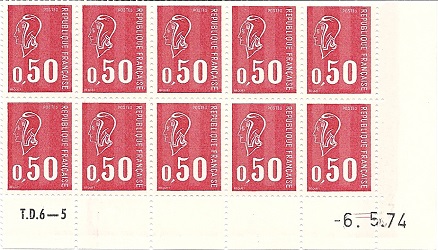
- dated plate block of 10 stamps from the 30th printing with the cylinder AH
- cylinder AH, from 2.5.74 to 16.5.74, stamps with 3 type D phosphor bands
- 4th part
- cylinder AH, from 30.5.74 to 12.6.74, stamps with 3 type D phosphor bands
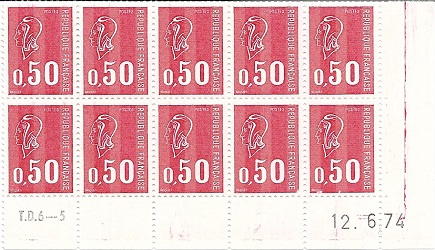
- dated plate block of 10 stamps from the 30th printing with the cylinder AH
- cylinder AH, from 30.5.74 to 12.6.74, stamps with 3 type D phosphor bands
31st printing, on the press TD6-4
- cylinder AL, from 8.4.74 to 9.4.74, overprinted CFA, tropical gum, stamps without phosphor band
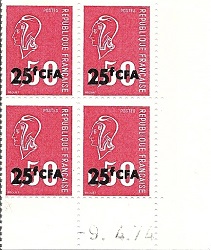
- dated plate block of 4 stamps from the 31st printing with the cylinder AL overprinted 25F CFA
32nd printing, on the press TD6-4
- cylinder AL, from 14.6.74 to 9.7.74, stamps with 3 type D phosphor bands
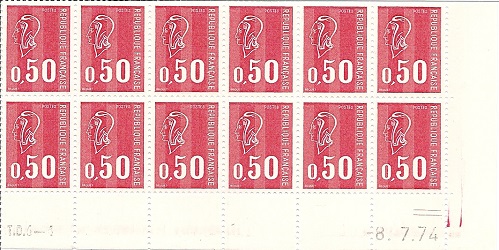
- dated plate block of 12 stamps from the 32nd printing with the cylinder AL
Inked lines from 2.7.74.
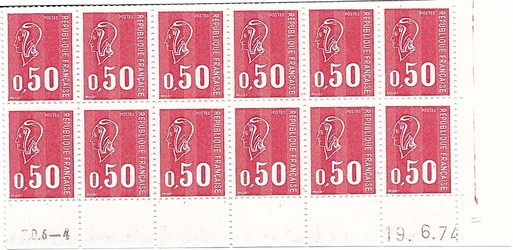
- dated plate block of 12 stamps from the 32nd printing with the cylinder AL with the two lines dry printed
- cylinder AI, from 11.7.74 to 9.8.74, stamps with 3 type D phosphor bands
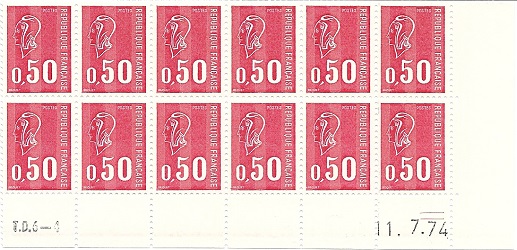
- dated plate block of 12 stamps from the 32nd printing with the cylinder AI
Lines non inked from 24.7.74.
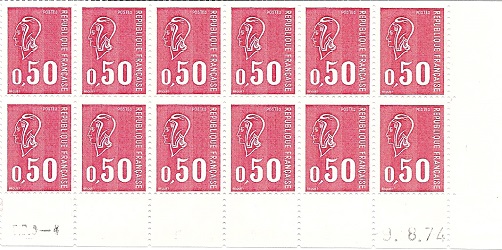
- dated plate block of 12 stamps from the 32th printing with the cylinder AI
33rd printing, on the press TD6-6
- cylinder AL, from 13.7.74 to 26.7.74, stamps with 3 type B phosphor bands
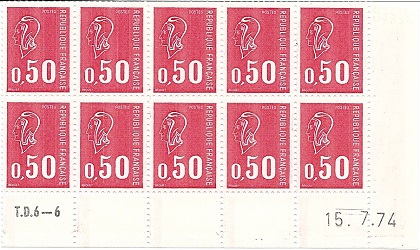
- dated plate block of 12 stamps from the 33rd printing with the cylinder AL
34th printing, on the press TD6-2
- cylinder AJ, from 18.7.74 to 25.7.74, stamps without phosphor band
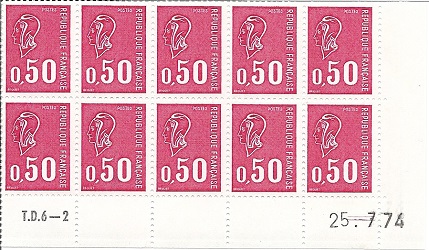
- dated plate block of 10 stamps from the 34th printing with the cylinder AJ, last printing day of the stamps without phosphor bands
35th printing, on the press TD6-1
- cylinder AJ, from 30.7.74 to 10.8.74, stamps with 3 type D phosphor bands
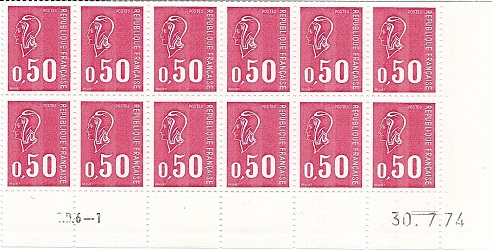
- dated plate block of 12 stamps from the 35th printing with the cylinder AJ
36th printing, on the press TD6-2
- cylinder AL, from 30.7.74 to 1.8.74, stamps with 3 type D phosphor bands
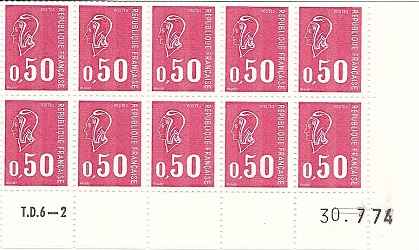
- dated plate block of 10 stamps from the 36th printing with the cylinder AL
37th printing, on the press TD6-7
- cylinder AM, from 15.10.75 to 17.10.75, stamps with 3 type B phosphor bands
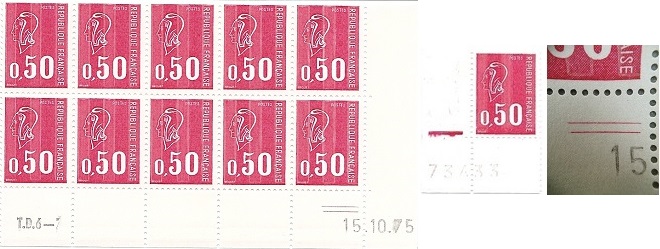
- dated plate block of 10 stamps from the 37th printing with the cylinder AM, RE and 2 lines from the cylinder AM
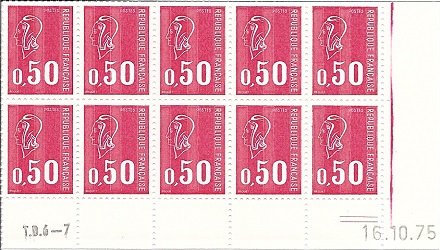
- dated plate block of 10 stamps from the 37th printing with the cylinder AM
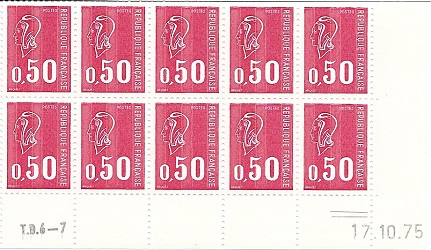
- dated plate block of 10 stamps from the 37th printing with the cylinder AM
38th printing, on the press TD6-1
- cylinder AM, from 15.10.75 to 18.10.75, stamps with 3 type D phosphor bands
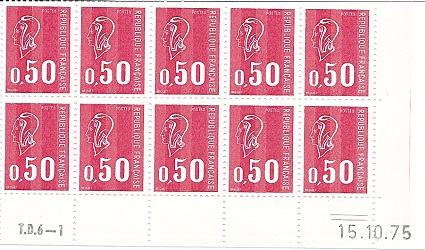
- dated plate block of 10 stamps from the 38th printing with the cylinder AM
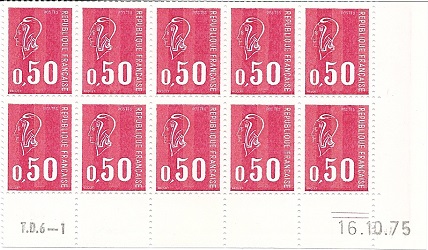
- dated plate block of 10 stamps from the 38th printing with the cylinder AM
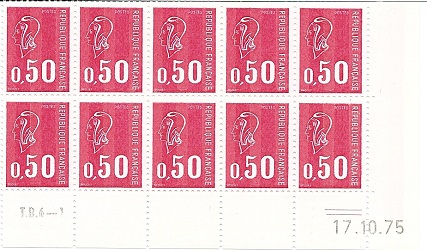
- dated plate block of 10 stamps from the 38th printing with the cylinder AM
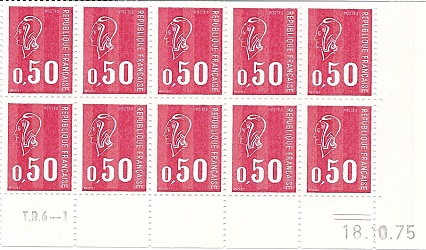
- dated plate block of 10 stamps from the 38th printing with the cylinder AM
The printings 37 and 38, for which I showed a dated plate corner for each printing day, raise a problem. They use the same form cylinder AM on two different presses on the days of 15, 16 and 17.10.75, which is physically impossible. There is thus a mistake somewhere in the dates. We may also note that the press TD6-1 printed stamps red 0,80F Marianne de Béquet from 23.9.75 to 5.11.75 with the form cylinder M, 3rd printing, which is another contradiction for the use of the press TD6-1 at the above dates.
39th printing, on the press TD6-6
- cylinder AN, from 24.5.76 to 8.6.76, stamps with 3 type B phosphor bands
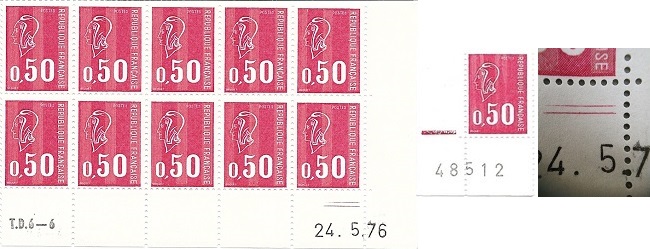
- dated plate block of 10 stamps from the 39th printing with the cylinder AN, RE and 2 lines from the cylinder AN
40th printing, on the press TD6-7
- cylinder AN, from 12.7.77 to 28.7.77, stamps with 3 type B phosphor bands

- recto and verso dated plate block of 10 stamps from the 40th printing with the cylinder AN, metropolitan gum
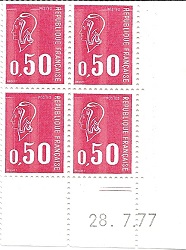
- dated plate block of 4 stamps from the 40th printing with the cylinder AN, las printing day of the stamp 0,50F Marianne de Béquet
On 12.7.77, stamps are printed on tropical gum paper:

- recto and verso dated plate block of 10 stamps from the 40th printing with the cylinder AN, tropical gum
We must note that on 11.7.77, the press TD6-7 printed stamps 1,00F Marianne de Béquet on paper with tropical gum, as shown on the two following pictures:

- dated plate block of 20 stamps from the 7th printing of the red stamp 1,00F Marianne de Béquet with tropical gum

- back of the above plate block showing the tropical gum
Some statistics as a conclusion
Based on the number of printing days of the stamps 0,50F Marianne de Béquet from sheets (and by considering known worked Saturdays as normal days, what is not completely exact), it is possible to establish statistics on the editions realized for this stamp. So
- 2 % of the stamps from sheets result from TD3 presses and thus 98 % from TD6 presses;
- Among stamps produced on TD6 presses, 2/3 are without phosphorescent band and 1/3 with 3 phosphorescent bands;
- Among stamps with 3 phosphorescent bands
- 70 % have phosphorescent bands of type D;
- 20 % have phosphorescent bands of type A;
- 10 % have phosphorescent bands of type B;
- 70 % have phosphorescent bands of type D;
In a more anecdotal evidence
- Among stamps without phosphorescent band
- 30 % were produced on the press TD6-7;
- 27 % on the press TD6-4;
- 25 % on the press TD6-2;
- 8 % on the press TD6-1;
- 5 % on the press TD6-3;
- 4 % on the press TD6-5;
- 30 % were produced on the press TD6-7;
- Among stamps with 3 phosphorescent bands
- 65 % were produced on the press TD6-4;
- 14 % on the press TD6-1;
- 12 % on the press TD6-5;
- 7 % on the press TD6-6;
- 3 % on the press TD6-7;
- 1 % on the press TD6-2;
- 65 % were produced on the press TD6-4;
Finally, the press TD6-1 printed at first stamps with type A phosphorescent bands, then stamps with type D phosphorescent bands (from 30.7.74). The press TD6-2 only printed stamps with type D phosphorescent bands. The press TD6-4 printed at first type A phosphorescent bands, then type D phosphorescent bands (from 16.1.73). The press TD6-5 only printed stamps with type D phosphorescent bands, the press TD6-6 only stamps with type B phosphorescent bands and the press TD6-7 stamps with type B phosphorescent bands.
 Site map
Site map
 Contact
Contact
 Legal notices
Legal notices
 Editors area
Editors area


2015-2017 © Etude monographique du 0,50F Marianne de Béquet - All rights reserved


 Home
Home



